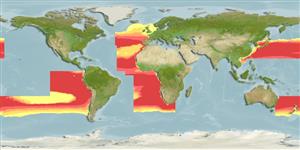>
Lophiiformes (Anglerfishes) >
Gigantactinidae (Whipnose anglers)
Etymology: Gigantactis: Greek, 'gigas' or 'gigantos' = gigantic + Greek, 'aktis' = ray (referring to the unusually long first dorsal-fin spine that functions as a lure in this genus) (Ref. 86949).
Environment: milieu / climate zone / depth range / distribution range
Ecologie
marien bathypelagisch; diepte 0 - 3000 m (Ref. 50610). Deep-water
Atlantic Ocean and Pacific Ocean.
Grootte / Gewicht / Leeftijd
Maturity: Lm ? range ? - ? cm
Max length : 43.5 cm SL (female)
Korte beschrijving
Morfologie | Morfometrie
Dorsale zachte stralen (totaal): 5; Anale zachte stralen: 4 - 5. Metamorphosed females distinguished by the following characteristics: have single proximal lateral pair and two distal pairs of large escal filaments and lacking distinct distal prolongation of the escal bulb; length of illicium less than 130% SL (93-126%SL); absence of escal papillae; relatively short dentary teeth (longest 3.3% DL), arranged in five or six longitudinal series; longest caudal fin rays 21-32.5% SL (Ref. 86949).
Levenscyclus en paargedrag
Maturiteit | Voortplanting | Paaien | Eieren | Fecunditeit | Larven
Masuda, H., K. Amaoka, C. Araga, T. Uyeno and T. Yoshino, 1984. The fishes of the Japanese Archipelago. Vol. 1. Tokai University Press, Tokyo, Japan. 437 p. (text). (Ref. 559)
Status op de Rode Lijst van het IUCN (Ref. 130435)
Gevaar voor de mens
Harmless
Gebruik door de mens
Meer informatie
Lokale namenSynoniemenMetabolismePredatorenEcotoxicologieVoortplantingMaturiteitPaaienPaaiaggregatiesFecunditeitEierenOntwikkeling van de eieren
Leeftijd/GrootteGroeiLengte-gewichtLengte-lengteLengtefrequentiesMorfometrieMorfologieLarvenLarvale populatiedynamiekRekruteringAbundantieBRUVS
ReferentiesAquacultuurAquacultuurprofielKweeklijnenGeneticaElectrophoresesErfelijkheidZiektesVerwerkingNutrientsMassaconversie
Tools
Speciale rapporten
Download XML
Internetbronnen
Estimates based on models
Preferred temperature (Ref.
123201): 3.1 - 11.2, mean 6.1 °C (based on 429 cells).
Fylogenetische diversiteitsindex (Ref.
82804): PD
50 = 0.5000 [Uniqueness, from 0.5 = low to 2.0 = high].
Bayesian length-weight: a=0.01000 (0.00244 - 0.04107), b=3.04 (2.81 - 3.27), in cm total length, based on all LWR estimates for this body shape (Ref.
93245).
Trofisch niveau (Ref.
69278): 4.4 ±0.7 se; based on size and trophs of closest relatives
Fishing Vulnerability (Ref.
59153): Moderate vulnerability (41 of 100).
